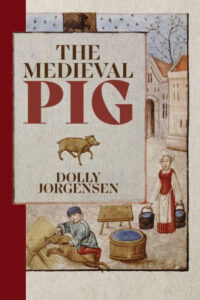 If you’ve spent any significant amount of time around them, you’ll know what I mean when I state “there’s something about pigs.” Adorable when they’re young, variably charming, eccentric, humorous, or frightening when they’re full grown, they have the capacity to be endearing to those who raise and tend them domestically, and maddening to those who are charged with controlling them in the wild. Said to be at least as intelligent as dogs, they can recognize human faces and show remarkable affection to their own kind as well as the humans who care for them. They are also capable of removing a man’s leg at a full charge, devouring the corpse of a grown man, and undermining public roads in their rooting for food. While in our present time they are primarily only found penned on a farm or less commonly roaming deep in the wilds, in the European Middle Ages they occupied a significantly wider range of spaces and interacted with people in many more ways than they now do.
If you’ve spent any significant amount of time around them, you’ll know what I mean when I state “there’s something about pigs.” Adorable when they’re young, variably charming, eccentric, humorous, or frightening when they’re full grown, they have the capacity to be endearing to those who raise and tend them domestically, and maddening to those who are charged with controlling them in the wild. Said to be at least as intelligent as dogs, they can recognize human faces and show remarkable affection to their own kind as well as the humans who care for them. They are also capable of removing a man’s leg at a full charge, devouring the corpse of a grown man, and undermining public roads in their rooting for food. While in our present time they are primarily only found penned on a farm or less commonly roaming deep in the wilds, in the European Middle Ages they occupied a significantly wider range of spaces and interacted with people in many more ways than they now do.
In her new book The Medieval Pig, Prof. Dolly Jørgensen presents a lively overview and examination of the many physical as well as societal spaces pigs inhabited during the title’s historical period. From their wild to their domesticated existence, both as agricultural products as well as free-roaming waste disposal units in villages and towns, to their use as symbols and allegories in literature and theology, her book presents the pig’s “numerous roles in medieval society, how pigs shaped human life, and how humans shaped theirs.”
Nota bene: this new book is the ninth and most recent volume in the Nature and Environment in the Middle Ages series from Boydell & Brewer. If your interests lie in both natural as well as medieval history, this series is one about which you should most certainly know.
If you enjoyed reading this, please consider signing up for The Well-read Naturalist's newsletter. You'll receive a helpful list of recently published reviews, short essays, and notes about books in your e-mail inbox once each fortnight.
